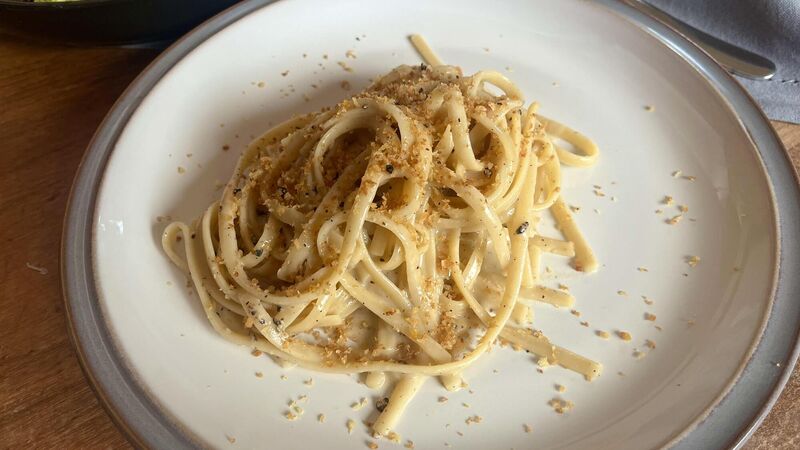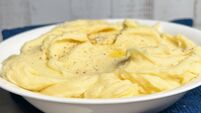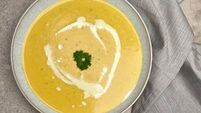Colm O'Gorman: Get a taste of Rome with my traditional cacio e pepe recipe

Cacio e pepe: a Roman classic with a zingy, lemon twist
I was in Rome for work a few weeks ago, and managed to eat out on one of the nights I was there. I adore Italian food, and some of my favourite recipes are simple pasta dishes which use just a few very good ingredients.
The classic Roman dish, Cacio e Pepe is for me, the ultimate example of such a recipe. The traditional dish I made with just three ingredients; pecorino cheese, spaghetti, and black pepper, hence its name which literally translates as ‘cheese and pepper’.
A few of my colleagues ordered this dish while we were in Rome and it was fabulous, so I had to give it a go when I got home.
This week’s recipe is the result; a slightly amped-up version of the classic, with some lemon added for a little bit of acidity to balance the creaminess of the cheese and a buttery, lemony, crisp golden crumb to finish the dish.
If you want a beautiful pasta dish that can be prepped and cooked in just twenty minutes, then this is the recipe you have been waiting for.
Some recipes for cacio e pepe use parmesan cheese instead of pecorino or a combination of the two.
I love parmesan and use it a lot in my cooking, but I think it is a little too intense in flavour for this dish.
Parmesan is made with cow’s milk and aged for at least twelve months. It is a hard cheese, with a nutty, slightly sweet, and intense flavour.
Pecorino on the other hand, is made from sheep’s milk, and is not matured, so it is lighter, softer, and creamier with a tangy fresher flavour.
In my opinion, pecorino works best in this dish for both flavour and texture. You will find pecorino in most larger supermarkets, but if you cannot get any, you can use parmesan instead.
You will have noted that the dish is called ‘cheese and pepper’, so the other core ingredient is lots of freshly roasted, crushed black pepper.
This is a spicy dish, so if you cannot tolerate a bit of heat, add half of the pepper to the sauce, and taste before adding more until it is perfectly to your taste.
Cacio e Pepe with Lemon
Serve with a simple salad of mixed lettuce leaves and some fresh cherry tomatoes tossed in a just a little good extra virgin olive oil, some balsamic vinegar, and a pinch of flaky sea salt.

Servings
4Preparation Time
10 minsCooking Time
10 minsTotal Time
20 minsCourse
MainCuisine
ItalianIngredients
4 tsp black peppercorns
400g bronze cut linguine or spaghetti
160g pecorino cheese
1 lemon
45g butter
30g panko breadcrumbs
Method
Toast the peppercorns in a dry pan over a high heat for a few minutes until they are toasted and fragrant. Crush them roughly in a mortar and pestle. Do not grind them too finely, keep a little texture for the best possible flavour. If you do not have a mortar and pestle, put the toasted peppercorns in a heavy plastic bag such as a Ziplock bag and crush them with a rolling pin.
Now, bring a large saucepan of water to the boil. Add a heaped teaspoon of salt and cook the linguine until it is almost done.
While the pasta is cooking, grate the pecorino cheese into a large bowl and set to one side. Grate the zest from the lemon and set that aside as well.
Next, make the crumb topping for the pasta. Melt half of the butter in a small pan. When the butter starts to foam, add the panko breadcrumbs, a little of the crushed black pepper and the juice of half the lemon. Stir the breadcrumbs until they turn golden and crisp, about three minutes over a medium heat should be perfect. When they are done, remove the pan from the heat and set it aside.
Test the pasta when it has about two minutes left to go of the cooking time given on the pack. You want it almost cooked, but with a bit of bite remaining as it will cook a little more when you make the sauce. Remove 250ml of the starchy cooking water and set to one side.
Turn off the heat and drain the pasta. Return the pasta to the pan and add the rest of the butter and the crushed black pepper. Toss the pasta to coat it thoroughly. Add half of the reserved cooking water to the bowl with the grated pecorino cheese and whisk to a thick sauce. Add more of the water a little at a time and keep whisking until you have a sauce that is the consistency of a cream sauce. Do not worry if it is not totally smooth at this stage as some of the cheese may not have completely melted. Pour the sauce into the hot pasta, add the zest and the remaining juice of the lemon, and toss vigorously until you have a smooth sauce that evenly coats all the strands of the linguine. Add a little more of the reserved cooking water if you need to loosen up the sauce a little.
Serve immediately on warm plates or pasta bowls with the buttery crumb scattered over the top with a fresh salad on the side.







